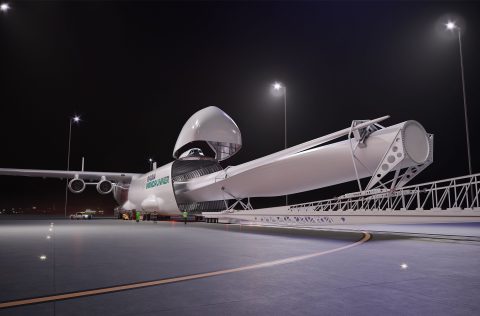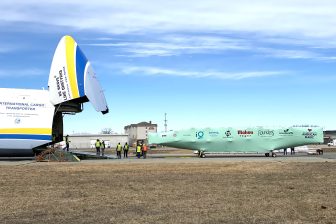
Can Radia make flying turbine blades to project sites a reality?
Transporting wind turbine blades on a plane could become a reality as Radia, funded in 2016, has been officially launched. The initiative aims to meet the challenge of delivering wind blades to previously inaccessible locations by designing, building and operating the world’s largest aircraft, WindRunner.
According to Radia, this unique aircraft will enable the deployment of the largest and best-performing wind turbines of the present and future to locations currently inaccessible to wind energy at a scale and speed that was previously impossible.
The WindRunner, will be able to fly large turbine blades and other components directly to wind farm sites. In addition, Radia will lead onshore wind energy expansion in partnership with industry leaders, and work with development partners to create new onshore wind farms, it said.
Radia has received nearly $100 million in funding from sources including LS Power, Good Growth Capital, Capital Factory, Caruso Ventures and ConocoPhillips.
“Radia will create a step-function improvement for onshore wind in profitability, lower cost, and higher consistency. This will result in more wind projects, more green fuel projects, lower energy price, more profits, and more money being invested in the energy transition,” Radia CEO Mark Lundstrom said.
Radia aims to answer the growing demands
Radia has launched at a time when demand on the electricity grid is increasing and there is doubt about its capacity and reliability. It is expected that the global data centre market will grow at a rate of more than 10% per year from 2023 to 2030. By 2030, US data centres alone are projected to consume 33 GW of power, mainly due to the growing use of AI.
Additionally, the increasing use of Electric Vehicles (EVs) will add to the demand for power. Currently, the grid is struggling with reliability as the gap between demand and power generation capacity continues to widen. Climate-driven severe weather events, such as the 2021 Texas ice storm, further challenge the reliability of the grid.
According to Lundstrom, Radia will answer those grid demands and the renewables industry’s need for growth and profitability alongside the commercial and societal need for clean power.
“Offshore turbines are more than two times as powerful as onshore turbines because they are bigger,” he said. “If we could move these large turbines onshore, they would be twice as profitable and open up three times more land for economically viable wind farms. Why not put them onshore? Because literal roadblocks stand in the way,” Lundstrom said.
“Radia will respond by building WindRunner to overcome these barriers, bring the benefits of offshore wind onshore, and deliver what we call GigaWind – the largest land-based turbines today and the even larger ones of the future,” Lundstrom continued.
“The result will be highly efficient wind energy at an enormous scale. From a business perspective that means that the onshore wind industry’s internal rate of return will double, attracting much more capital to renewables. From an energy security and environmental perspective, it means the lowest cost of clean energy to power the grid, to power commercial applications such as data centres and hard-to-decarbonize industries such as steelmaking and to generate green molecules – green hydrogen, green ammonia and sustainable aviation fuel. GigaWind will allow us to reduce cost and increase generation consistency, resulting in as much as a 35 per cent cost reduction – which in turn will help the world to meet its decarbonization targets.”
Removing barriers
Radia aims to maximize the potential of onshore wind energy by eliminating obstacles to its implementation. The biggest wind turbines are highly energy efficient, as doubling the length of a turbine blade increases its power output by approximately four times. Nevertheless, their large size makes them viable only for offshore use.
Radia claims its WindRunner aircraft will be designed to enable onshore wind to scale by delivering large wind turbine blades and other components directly to wind farm sites. The aircraft would be capable of landing on short, semi-prepared runways, including those made of packed dirt, greatly expanding the number of locations available for large turbines.
This creates opportunities to reduce transmission costs, increase reliability by building wind energy sites closer to demand, create hybrid wind/solar sites to produce clean power around the clock and throughout the year, and generate the large amounts of clean electricity needed to produce green hydrogen.
WindRunner would only require a 6,000-foot (1800 metres) semi-prepared dirt or gravel landing strip at a wind farm to deliver its payload. This also enables it to land at almost any commercial airport around the world. WindRunner will be 356 feet (108 metres) long and its volume is 12 times that of a 747, and an overall length of 356 feet (108 metres) to carry the largest payloads ever moved by air.
Radia plans to produce a fleet of certified aircraft at its U.S. assembly site. WindRunner is more than halfway through the time required to design, build and certify an aircraft.
Partnering towards faster deployment
Radia has collaborated with top aerospace companies to develop and construct WindRunner, and with wind turbine manufacturers to deploy large onshore turbines. Radia doesn’t produce wind turbines itself; instead, Radia has partnered with the world’s leading wind turbine manufacturers to provide their best products today and tomorrow to more locations. Radia calls this initiative GigaWind, and will work with farm developers to construct new sites – even in low-wind locations where the large turbines will be more productive – resulting in an expanded onshore wind market that generates more clean power.
You just read one of our premium articles free of charge
Want full access? Take advantage of our exclusive offer




